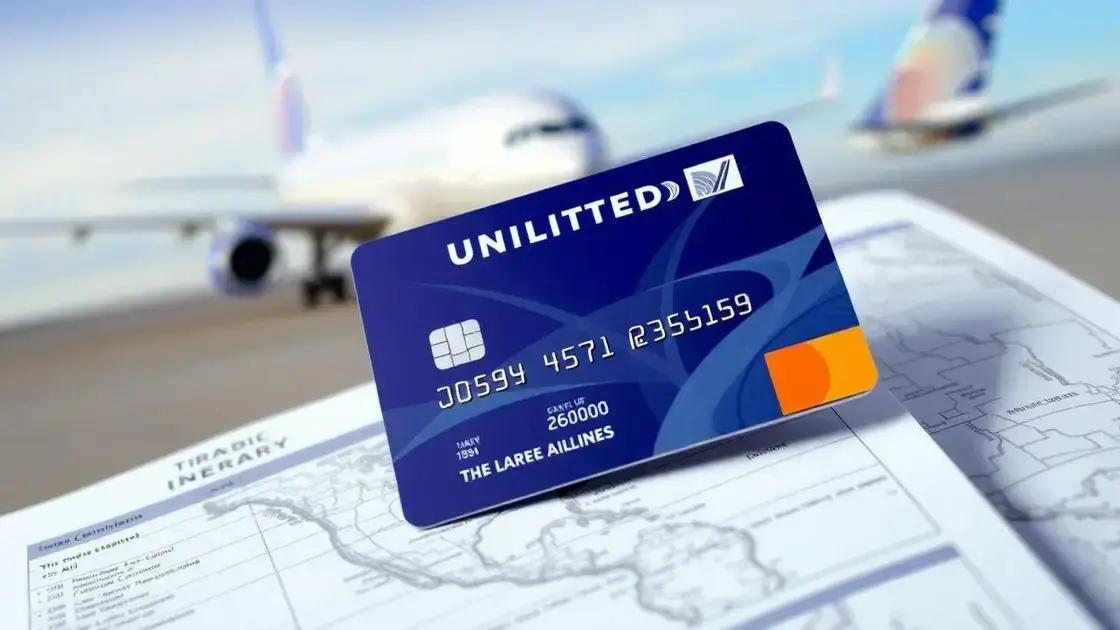Latest updates on credit card and digital wallet integration

Anúncios
Latest updates on credit card and digital wallet integration show a growing trend towards enhanced security, convenience, and the adoption of biometric authentication and cryptocurrencies in payment systems.
Latest updates on credit card and digital wallet integration are transforming how we handle payments. Have you ever wondered how these innovations impact your everyday transactions? Let’s dive into what’s changing.
Anúncios
The evolution of credit card technology
The evolution of credit card technology has significantly changed the way we make purchases. From the introduction of plastic cards to contactless payments, advancements have made transactions easier and more secure. This transformation continues to shape the retail landscape.
The Early Days of Credit Cards
Credit cards first emerged in the 1950s. Initially, they were issued by banks and could only be used at specific establishments. People had to remember the number on the card and present it at checkout, which was not always convenient.
Anúncios
Chip Technology
In the 2000s, the introduction of chip technology added an extra layer of security. These chips store encrypted data, making it harder for fraudsters to copy card information. Now, many cards also come with EMV chips, complying with global security standards.
- Improved card security through chip technology
- Reduction in card fraud incidents
- Compliance with international standards
As consumers demanded more secure transactions, banks began adopting these chips on a larger scale. Today, nearly all credit cards feature a chip, enhancing the confidence of users.
Contactless Payments
With the rise of smartphones, contactless payments emerged, allowing users to complete transactions by simply tapping their cards or devices at a point of sale. This method is fast, efficient, and continues to gain popularity.
- Speedy transactions without swiping
- Convenience for everyday purchases
- Integration with digital wallets
Furthermore, the adoption of digital wallets has transformed how we manage our finances. Apps like Apple Pay and Google Wallet allow users to store multiple cards and make payments directly from their smartphones.
The future of credit card technology looks promising, with innovations such as biometric authentication gaining traction. Imagine paying for something by simply scanning your fingerprint! This future could be closer than we think, making transactions even more secure.
Current trends in digital wallet usage
The current trends in digital wallet usage show a significant shift in how consumers handle their finances. More people are opting for digital wallets due to their convenience and security. This trend is shaping a new era in payment methods.
Rise in Popularity
Digital wallets have gained immense popularity, especially among younger generations. Many prefer using their smartphones to pay rather than carrying around cash or cards. This transition is driven by the convenience of having multiple payment options in one place.
Key Features of Modern Digital Wallets
Today’s digital wallets offer features that enhance user experience and security. Not only can users store their credit and debit cards, but they can also keep track of loyalty cards and rewards.
- Seamless integration with online and offline stores
- Instant money transfers between users
- Enhanced security measures, like biometric authentication
As consumers become more accustomed to these features, the demand for digital wallets is expected to grow even more. In addition, many retailers are adjusting their systems to accept these modern payment methods, making transactions easier for everyone.
Impact of COVID-19
The COVID-19 pandemic accelerated the adoption of digital payments. With a focus on hygiene and safety, many consumers turned to contactless payment options. Digital wallets became the go-to solution for shopping both in-store and online.
This change has made it clear that consumers value safety and convenience. As a result, businesses have been encouraged to adopt technologies that support digital payment options.
Furthermore, the trend shows no signs of slowing down. As technology continues to advance, features like cryptocurrency support are emerging in digital wallets, appealing to a broader audience.
Benefits of integrating credit cards and digital wallets

The benefits of integrating credit cards and digital wallets are transforming the payment landscape. This integration offers users an enhanced experience while also providing security and convenience. Many consumers now prefer having multiple payment options at their fingertips.
Convenience and Speed
One major benefit is the convenience it provides. Users can easily pay for purchases using their smartphones without the need for physical cards. This speeds up the checkout process, making shopping a breeze.
Enhanced Security
Integrating credit cards with digital wallets also improves security. Digital wallets use encryption and tokenization, which protect users’ financial information. In the event of theft or loss, users can remotely lock their wallets or disable cards.
- Immediate access to funds
- Reduced risk of theft with encrypted transactions
- Convenient control over payment methods
This level of security is crucial in today’s digital world, where cyber threats are common. Consumers feel more secure knowing their data is protected throughout their transactions.
Loyalty Programs and Rewards
Another significant advantage is the ability to link loyalty programs and rewards. Consumers can earn points or cash back directly through their digital wallets. This integration means no more forgetting to scan a loyalty card at checkout.
Additionally, businesses benefit from integrating credit cards and digital wallets as they can capture consumer behavior data. This data helps in creating personalized marketing strategies to enhance customer engagement and satisfaction.
With these combined advantages, it’s clear that the future of payments lies in seamless integrations that enhance user experience while providing security and convenience.
Challenges faced by consumers and businesses
Despite the advantages of integrating credit cards and digital wallets, there are also significant challenges faced by consumers and businesses. Understanding these challenges is vital in navigating the evolving payment landscape.
Security Concerns
Security is a top concern for both consumers and businesses. Digital wallets can be vulnerable to cyber threats, including hacking and phishing attacks. Consumers worry about their financial data being compromised while making transactions. Businesses must invest in robust security measures to protect sensitive customer information.
Adoption Barriers
Another challenge is the adoption of these new technologies. Some consumers may be hesitant to switch from traditional payment methods due to unfamiliarity or a lack of trust. Similarly, businesses, especially smaller ones, may find it difficult to implement digital payment systems without proper infrastructure.
- Resistance to change from consumers
- Cost of implementing new payment systems for businesses
- Potential technical issues during transitions
As a result, businesses need to educate their customers about the benefits and security of digital wallets to encourage their acceptance.
Complex User Experience
Additionally, while many digital wallets offer convenience, the user experience can sometimes be confusing. Users may struggle to navigate apps or face issues with payment processing. This can lead to frustration and potentially lost sales for businesses.
Streamlining the user experience is crucial in addressing these challenges. Companies must focus on creating intuitive interfaces that make transactions straightforward and user-friendly.
Despite these challenges, the trend toward digital payments is growing. Addressing these hurdles effectively can lead to a more inclusive and secure payment environment for everyone.
Future predictions for payment integrations
The future predictions for payment integrations suggest exciting developments in how we make transactions. As technology continues to evolve, we can expect payment systems to become even more seamless and efficient.
Increased Use of Biometric Authentication
One significant trend will be the rise of biometric authentication. Consumers will increasingly be able to use their fingerprints or facial recognition to authorize payments. This technology not only enhances security but also improves user convenience.
Integration of Cryptocurrencies
Another trend is the integration of cryptocurrencies into mainstream payment systems. Digital currencies like Bitcoin and Ethereum are becoming more widely accepted. This shift could transform how we view money and transactions.
- Wider acceptance in retail and online shopping
- Potential for lower transaction fees
- Increased interest in alternative currencies
As more consumers become comfortable using cryptocurrencies, we may see them becoming a standard payment option alongside traditional methods.
Enhanced Personalization
Future integrations will also focus on personalization. Businesses will leverage data to offer customized payment solutions that cater to individual consumer preferences. This means tailored loyalty rewards and targeted promotions based on shopping habits.
The automation of payments will further streamline the process. Imagine a world where subscriptions renew automatically without the need for user input. This convenience will appeal to many consumers.
Overall, the landscape of payment integrations is set for exciting changes ahead. With advancements in technology, we will likely see greater security, convenience, and innovation in how we handle our finances in the years to come.
In conclusion, the integration of credit cards and digital wallets is changing how we make payments. We can expect better security, convenience, and personalization in the future. The use of biometric authentication and cryptocurrencies will likely grow, making transactions even easier. As we move forward, staying informed about these trends will help consumers and businesses adapt to the evolving payment landscape.
FAQ – Frequently Asked Questions about Credit Card and Digital Wallet Integration
What are the main benefits of using digital wallets?
Digital wallets offer convenience and speed, allowing users to make quick transactions without the need for cash or physical cards.
How does biometric authentication improve security?
Biometric authentication uses fingerprints or facial recognition to authorize payments, making transactions more secure and reducing the risk of fraud.
What challenges do businesses face when adopting digital payment systems?
Businesses may encounter challenges such as high implementation costs, technical issues, and the need to educate customers about new payment options.
How are cryptocurrencies impacting payment integrations?
Cryptocurrencies are becoming more accepted in mainstream payments, potentially offering lower transaction fees and new options for consumers.






